ISSN: 1204-5357
ISSN: 1204-5357
| Sujana Adapa Lecturer in Marketing, University of New England Postal Address: School of Business, Economics and Public Policy, Faculty of The Professions, UNE, Armidale 2351 NSW, Australia Email: sadapa@une.edu.au Sujana Adapa is a Lecturer in Marketing in the School of Business, Economics and Public Policy at the University of New England, Armidale, Australia. Her research interests include services marketing, cross-cultural studies, adoption and diffusion of innovations and sustainable marketing and management practices. |
Visit for more related articles at Journal of Internet Banking and Commerce
The goal of this study was to investigate the factors that influence how consumers continue to use, and how frequently they use, internet banking in Australia. Patterns of continued use and frequency of use of internet banking have been neglected as most of the existing studies focus on either consumer adoption or acceptance of internet banking. However, in comparison to new customer acquisition, measures of continued and frequent use of internet banking are related to a cost-effective marketing strategy aimed at retaining customers. This study addresses a gap in existing literature which requires the application of more integrated theory testing and the identification of factors that influence the continued and frequent use of internet banking. The study sets out to develop a framework based on theoretical models related to the acceptance of technology and diffusion of innovations theory that encompasses technology, channel, social and value for money factors as predictors in the identification of influential factors for consumers and their continued and frequent use of internet banking.
Keywords |
| Continued Use, Frequent Use, Internet Banking, Technology Factors, Channel Factors, Social Factors, Value for Money Factors |
INTRODUCTION |
| Several businesses are utilising technological advancements in order to make their services more accessible to consumers. One such business entity is the retail banking sector that has been using a wider array of information systems to satisfy its customers (Wresch & Fraser 2006). The retail banking industry realised that relying exclusively on the traditional price factors for competition was a questionable way to increase revenue and market share in the industry. This was due to the fact that the two largest expenses incurred by banks are associated with the maintenance and overhead costs of branch networks and their associated human resources (Durkin et al. 2008). Banks started to realise that relying on non-price factors provided alternative strategies for differentiation, gaining competitive advantage and cost cutting (Daniel 1999). As a result, the financial services industry has become much more competitive over the last few years (Thornton & White 2001). In an intensifying competitive environment, superior distribution strategies relating to how to communicate with, and deliver products to, the customer effectively provides a comprehensive advantage to the banking institutions (Kerem et al. 2003). Moreover, customers are also demanding greater convenience and accessibility, as reflected in longer branch opening hours and an increase in the choice of service delivery mechanisms. On a global scale, many banks have started to set in place more cost-effective alternative service delivery systems (Shih & Fang 2004). The trend has seen the proliferation of multiple service delivery channels through which consumers can interact with banks. Therefore, modern banks provide their consumers with increased channel choice that reaches out to consumers through many different routes. Alternative service delivery systems such as Automated Teller Machines (ATMs), telephone, internet and wireless channels are now available to the consumers to perform their banking transactions in addition to the traditional branch banking (Reid & Levy 2008; Akinci et al. 2004). It has been widely accepted that internet banking is possibly the most cost-effective channel for providing electronic banking services and products efficiently to prospective customers (Giglio 2002; Robinson 2000; Sathye 1999). However, there are marketing and management issues that arise from relying on such new and different distribution channels. |
| The emergence of internet banking has meant that banking activities are no longer subject to time and geographical constraints (Karjaluoto et al. 2002) as internet banking offers 24 hour accessibility to consumers (Ismail & Panni 2009). Gurau (2002) emphasised that internet banking services are attractive to target markets for both individual consumers and corporate clients. Lee & Lee (2001) noted that internet banking provides easier access to bank accounts and lower service charges. Furthermore, internet banking is associated with high speed of service and lower transaction costs (Chang 2002). There are a number of internet banking studies that have investigated factors that influence a consumer’s intention to adopt or their acceptance of internet banking (Gerrard & Cunningham 2003; Lee et al. 2003). A persistent argument is that prior studies on internet banking adoption by consumers, and the factors responsible for their adoption of the internet, have produced inconclusive and sometimes conflicting results. This has culminated in a difficulty in articulating the precise findings of internet banking research (Ndubisi & Sinti 2006). Thus, the findings from research on internet banking from the consumer’s perspective remains unclear and in many ways impractical as it is not applied to the business context. |
| In the past decade, the objective of most research in internet banking research has been to analyse the acceptance and adoption of internet banking service delivery channels and to understand the factors which lead to the adoption process (Chen et al. 2005). Since its introduction, internet banking, due to its speed and convenience, has been widely accepted by consumers as a service innovation (Klopping & McKinney 2004). In recent years, internet banking transactions increased to a greater extent, indicating the voluminous nature of transactions carried out by the internet banking consumers (Kasheir et al. 2009). This phenomenal uptake and use of internet banking, together with the internet banking experience, modifies the behaviour of individuals towards the channel (Gefen et al. 2003). Change is evident in consumers’ initial perceptions and heightens the need to understand not only consumers’ pre-adoption behaviour, but also post-adoption behaviour (Yu et al. 2005). |
| It is only recently that researchers have started to understand the importance of consumers’ continued, as well as frequent use of internet banking and its impact on the financial performance of the banking sector (Kasheir et al. 2009; Yousafzai et al. 2005). Continued and frequent use of internet banking are often neglected in the marketing literature, as most studies focus on either consumer adoption or acceptance of internet banking (Eriksson & Nilsson 2007). However, in practice, in comparison to new buyer acquisition, continued and frequent use is related to a cost-effective marketing strategy aimed at retaining customers. The goal of any business entity in the long term is to increase its productivity and maximisation of the profits. Retention strategies foster customer relationship management and reduce customer switching behaviour (Kasheir et al. 2009). In order to achieve this, it is vital to concentrate on the consumer’s continued and frequent use of a particular product or service rather than solely on their acceptance of the service (Kim & Malhotra 2005). With these considerations in mind, and the existing gaps in the knowledge surrounding consumers’ continued and frequent use of internet banking, the present research focuses on exploring the antecedents to consumers’ continued and frequent use of internet banking. |
RESEARCH CONTEXT |
| The present study was conducted in Sydney for a number of reasons. According to the Australian Bureau of Statistics, Sydney is the most populous city in Australia, with a metropolitan area population of approximately 4.28 million (ABS 2008). The largest productive economic sectors in Sydney include property and business services, retail, and health and community services. Financial services industry is the fastest growing service industry in New South Wales (NSW), recording an average growth rate of more than 9 percent between 1995 to 1996 and 2005 to 2006. Sydney is also identified as increasingly dominant in finance as its proportion of market share in the Australian financial services industry grew from 39 percent in 1995 to 42 percent in 2005. Banking is the dominant sector of the Australian financial services industry, accounting for 50 percent of the total assets. This sector continues to grow with the recent establishment of four offshore banks in Sydney: the China Construction Bank, Bank of Baroda, Bank of Ireland and Australia’s first foreign central bank, The Peoples’ Bank of China. Moreover, Sydney is the largest corporate and financial centre in Australia and in the Asia-Pacific region. Of the 55 authorised deposit-taking banks in Australia, 53 have operations in Sydney. Furthermore, Sydney is the location of the Reserve Bank of Australia, the Australian Securities Exchange and the Australian Financial Markets Association and is the headquarters for 90 banks (ABS 2008) within the geographical location of Sydney due to its importance as a retail banking centre for Australia. |
LITERATURE SYNTHESIS |
| The correlation between technological advancements and increase in business productivity is feasible only if they are accepted by the intended users (Venkatesh et al. 2003). The objective of most research on internet banking has been to analyse the process of acceptance, intention to adopt or adoption of the new service delivery channel and compare it with the other service delivery channels offered by banks (Yousafzai et al. 2005). Nevertheless, in recent years internet banking has shown increasing uptake by consumers and there are more and more consumers who have carried out internet banking transactions several times. This, together with the fact that when consumers have experience with internet banking their behaviour is modified, which produces a change in their initial perceptions about internet banking. Such a change in consumer behaviour makes it necessary to study not only the pre-adoption behaviour of consumers, as in previous research, but also the post-adoption behaviour towards internet banking (Hernandez et al. 2008). |
| Thus, from the existing research, possible theoretical models that provide a comprehensive understanding of user acceptance of innovations come from disciplines such as information systems, psychology and sociology. The present study proposes the application of two main theoretical models that of an integrated technology model of consumer adoption and diffusion of innovations model, in order to explain the factors that might have a significant impact on the usage patterns of internet banking by consumers in Australia. |
| According to Bagozzi (2007) the Theory of Reasoned Action, Theory of Planned Behaviour and Technology Acceptance Model all seem to neglect group, social and cultural aspects of the consumer decision-making process. These models have been heavily criticised as they rely to on naïve and simplified notions of human emotions. Mostly these models depend on a purely deterministic framework and often selfregulation processes are not taken into consideration. The models also attempt to evaluate the consumers’ post-purchase decision-making process; however, in reality, these theories rely on consumers’ perceptions of innovation characteristics as a significant predictor of behavioural intention. However, Kasheir et al. (2009) and many researchers believe that these theories are incomplete and that integrating aspects of these theories provides a better understanding and explanation of consumer evaluation of the post-purchase decision-making process rather than what is provided by each theory alone. |
| Consumers’ continued use and frequency of use of internet banking assessment may be more complex than current theories explain, due to the fact that consumers often need to abandon or minimise their current behaviour and usual concerns associated with technological advancements (Falk et al. 2005). Also, usage depends upon an individual’s capability and capacity to engage with these proliferated service delivery channels (Walker & Johnson 2006). Often, continued use is related to the technology updating mechanisms (Kim & Malhotra 2005). Consequently, existing models, whilst indicative of internet usage behaviour, are not complete in terms of all of the factors consumers refer to in their decision-making. |
| Technological advances in society have an impact on marketing practices. Information and knowledge about markets, customers and competitors becomes more complex and available with the implementation of technological innovations (Rust & Espinoza 2006). As a result, better services can potentially be offered by companies to satisfy each customer’s specific needs. Thus, a clear shift from traditional product orientation to customer orientation in marketing practice is evident as businesses vigorously compete in the application of technology to services (Lovelock & Wirtz 2004). Therefore, service delivery has become the central focus of many businesses today, paving the way for a new paradigm described as ‘the service revolution’. Technology-enabled services allow interactive communication between the service provider and the customer and enhance the relationship with the service provider (Rust & Thompson 2006). |
| Some later studies started realising the importance of consumers and their channel interactions and emphasised the degree of congruence between a particular service and a channel (Morrison & Roberts 1998). The approach of the present study is different in two ways. Firstly, it makes an attempt to focus on consumer channel interactions during their post-adoption behaviour. Secondly, channel-related factors are identified as consisting of sub-dimensions such as consumers’ perceptions of their self-efficacy, risk, trust and personalisation. |
| Social influence is identified extensively in the existing literature as normative pressure, while subjective norm refers to a person’s perception of the social pressures put on him/her to perform or not to perform the behaviour in question (Ajzen & Fishbein 1980). The role of social influence in an individual’s decision whether or not to use a technology is complex and subject to a wide range of contingent influences (Venkatesh et al. 2003). Internet banking as a service innovation creates uncertainty and individuals who are uncomfortable with uncertainty will tend to interact with their social network before making a decision (Lu et al. 2005). Mathieson (1991) reported that social variables could be important in influencing consumers’ perceptions if they capture variance that is not already explained by other variables. |
| The creation of value is key in marketing (Lindgreen & Wynstra 2005). The role of marketing is ‘to assist the firm to create value for its customers that is superior to competition’ (Tzokas & Saren 1999, p.53). It is essential to know what consumers actually value before one can truly understand the choice of a particular service delivery channel, its continued usage and frequency of usage. It is also of equal interest in identifying the attributes that are most important in consumers’ judgments of value. |
| Continuance theory within the discipline of information systems stems from initial research in marketing. Expectation-confirmation theory emerged from the consumer behaviour and services marketing literature and has proven broadly robust in a number of services contexts (Dabholkar et al. 2000). The general thrust of this theory is the assessment of post-purchase intentions as influenced by initial expectations about a product or service, subsequent adoption and use and the formation of perceptions about performance as influenced by the confirmation, determining the level of satisfaction with a purchase and subsequent repurchase (Bhattacharjee 2002). The focus on the continued usage construct in this study is in line with a core body of previous information systems research (Legris et al. 2003). Frequency of usage refers to how often the product or service is used, regardless of the product or service functions used, or the different applications for which the product or service is used. Thus, frequency of usage is identified in the existing literature as analogous to the depth of usage of a particular product or service (Gatignon & Robertson 1985). |
RESEARCH METHODOLOGY |
| The researcher was interested in identifying potential factors influencing consumers continued usage and frequency of usage of internet banking in an Australian context. The researcher was also interested in whether factors influencing consumers’ preadoption of internet banking, which have emerged mostly from American studies, are relevant in the Australian context and whether or not the same factors are responsible for influencing consumers’ post-adoption behaviour such as continued usage and frequency of usage of internet banking. The questionnaire was distributed to both the users and non-users of internet banking. Out of the 1308 respondents intercepted in the foyer of the shopping mall, 698 respondents answered the survey questionnaire. Of these questionnaires obtained, only 683 questionnaires were valid with complete responses, thus indicating 52.5 percent of the response rate. Among the 683 usable questionnaires, 372 were completed by users and the remaining 311 by non-users of internet banking. For the purpose of this study only data obtained from the internet banking users has been further analysed. Initially all questionnaires obtained were checked for completeness. Vetting of the questionnaires obtained was done by the researcher with the objective of increasing accuracy and precision. Vetting was done by screening the questionnaires to identify illegible, incomplete, inconsistent and ambiguous responses. A coding process was followed involving the assignment of a code to represent a specific response to a specific question along with the data record and column position that code will occupy. Coded data were entered from the questionnaires to SPSS 17.0 computer program (SPSS 2008). The SPSS data records were checked thoroughly and extensively for consistency and missing responses as part of the data cleaning process. |
| Based on the theoretical and empirical guidelines, the study used exploratory factor analysis for data reduction and summarisation. Two statistical measures that help to assess the factorability of the data are the Kaiser-Meyer-Olkin (KMO) measure of sampling adequacy and Bartlette’s test of Sphericity (Kaiser 1970, 1974; Bartlett 1954). KMO measure of sampling adequacy varies between zero and one, and values closer to one are better. A value of 0.6 is a suggested minimum. Bartlett’s test of Sphericity tests the null hypothesis and further represents that the correlation matrix is an identity matrix. In order to obtain more interpretable solutions, rotation is to be specified. With an oblique rotation, such as promax rotation, the factors are permitted to be correlated with one another (Widerman 1993). Promax rotations produce pattern matrix, factor structure matrix and factor correlations matrix (Cooksey 2007). The factor pattern matrix represents the linear combination of the variables with coefficients typically ranging between -1.0 and +1.0. The factor structure matrix represents the Pearson correlations between the variables and the factors and is often called the factor loading matrix (Pett et al. 2003). The factor correlation matrix provides the estimation of the degree of correlation that might exist between the factors (Raubenheimer 2004). Eigenvalues summarise the variance explained by each factor in the variables out of the total available. |
| The variables used to operationally define each major construct were factor analysed separately (technology, channel, social, value for money and continued use factors). Technology factors included in the present study were operationalised in a manner consistent with previous internet banking studies in other research contexts (Hernandez & Mazzon 2007; Chan & Lu 2004). For this study, technology factors were measured using a 17 item scale consisting of five sub-dimensions (relative advantage, compatibility, complexity, trialability and result demonstrability) (Moore & Benbasat 1991). Channel factors were operationalised in accordance with work by Hernandez & Mazzon (2007), Chan & Lu (2004) and Tan & Teo (2000). For the purpose of this study, channel factors were measured using the 15 item scale consisting of four subdimensions such as perceived self-efficacy, perceived risk, perceived trust and perceived personalisation. Social factors were operationalised consistent with work by Chan & Lu (2004) and Venkatesh & Davis (2000). Social factors were measured using the six item scale consisting of two sub-dimensions subjective norm and interpersonal influence. Value for money factors were operationalised in accordance with work by Thomas & Sullivan (2005), Keen et al. (2004) and Petrick (2002). In this study, value for money factors were measured using the eight item scale consisting of two subdimensions perceived benefits and perceived costs. Continued use factors were operationalised consistent with work by Hernandez & Mazzon (2007) and Venkatesh & Davis (2000). Continued use factors were measured using a three item scale without any sub-dimensions. Data were collected from the respondents who were current internet banking users, using 17 items from TD1 to TD17, which used a six-point Likert scale defined as (1) Strongly Agree, (2) Agree, (3) Neither Agree nor Disagree, (4) Disagree, (5) Strongly Disagree, and (6) Unable to Rate. |
| Once the factors were identified, Cronbach’s alpha internal consistency reliability coefficients were computed for each identified factor. Respondents were given scores on each identified factor by averaging the scores for the item comprising each factor (a unit-weighted factor scoring scheme). |
RESULTS |
| Once missing data had been dealt with, the summary scores of the interval data were computed, including several scale items. Usually good measures included in the questionnaires contain a mixture of positively and inversely keyed-in items. Therefore, according to Schumacher and Lomax (2004), recoding of the reverse scored scale items is an essential pre-requisite. Without reverse scoring, the statistical combining of items to form aggregated scale scores will be misleading. Of the different independent variables included in the study only technology and channel constructs have reverse scored scale items. Table I presents the original, as well as the recoded reverse scored scale items, of the technology factors. |
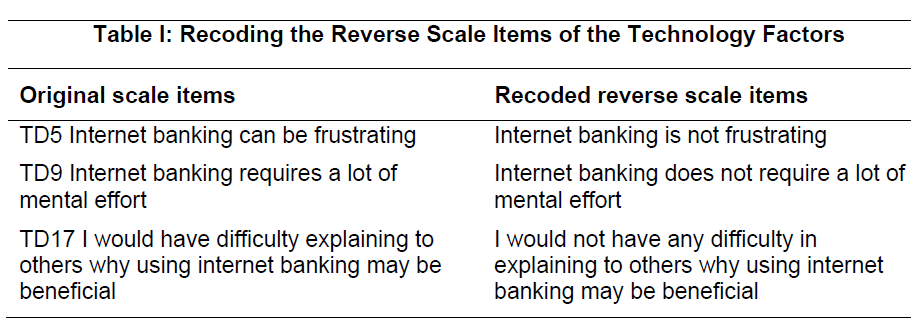 |
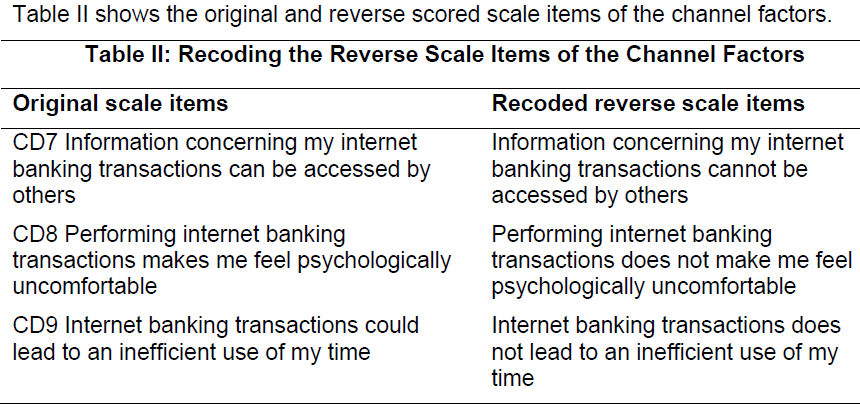 |
| Data transformations usually involve a nonlinear mathematical conversion of the raw scores (Keller 2006). A log transformation was employed to stretch out the lower end and compress the upper end of variable distributions, with the result that positively skewed data will tend to become more symmetrical in shape (De Vaus 2002). Technology, channel, social and value for money factor items were subjected to logarithmic transformations. |
| Exploratory factor analysis provides a class of techniques useful for condensing many variables into a smaller, manageable and more reliable subset of dimensions or factors (Fabrigar et al. 1999). Principal component analysis, in particular, attempts to identify linear combinations of correlated items which form measurement scales. Principal component analysis is the most appropriate tool to explicitly combine variables in a weighted manner to form components that account for the maximum amount of variability in the variables scores (Cooksey 2007; Habing 2003). Furthermore, the use of principal component analysis provides more robust results whilst dealing with the missing data patterns and the results obtained are similar to using common factor analysis. |
| Exploratory factor analysis was performed using principal components and promax rotation. Certain scale items were deleted from entering further analysis as they did not meet the essential criteria such as low factor loading values, less eigenvalues or low item-to-total correlations (Hair et al. 2006). The log transformed scale items LTD5, LTD11 and LTD17 of technology factors were deleted from the original scale due to the presence of factor loadings with an absolute value of less than 0.4. Similarly, the LCD8 scale item was deleted from the channel factors due to the presence of low loading values. A refined exploratory factor analysis was performed excluding the scale items that did not satisfy the assumptions of the exploratory factor analysis. |
Principal Component Analysis Output for the Technology Factors |
| The principal component analysis method and a promax rotation of the technology determinants constituting fourteen scale items was conducted on a random sample (N = 372) of Australian internet banking users and is presented in Table III. The KMO measure of sampling adequacy (0.819) was satisfied indicating that the present data were suitable for principal component analysis. Similarly, Bartlett’s test of Sphericity was significant (p < 0.001), indicating sufficient correlations between the variables to proceed with the analysis. A two component solution provided the clearest extraction, using the Kaiser-Guttman retention criterion of eigenvalues of more than one. The component correlation matrix indicates that the two components emerged from the technology factors to be positively correlated (0.427) at a moderate level and are fairly well discriminated. |
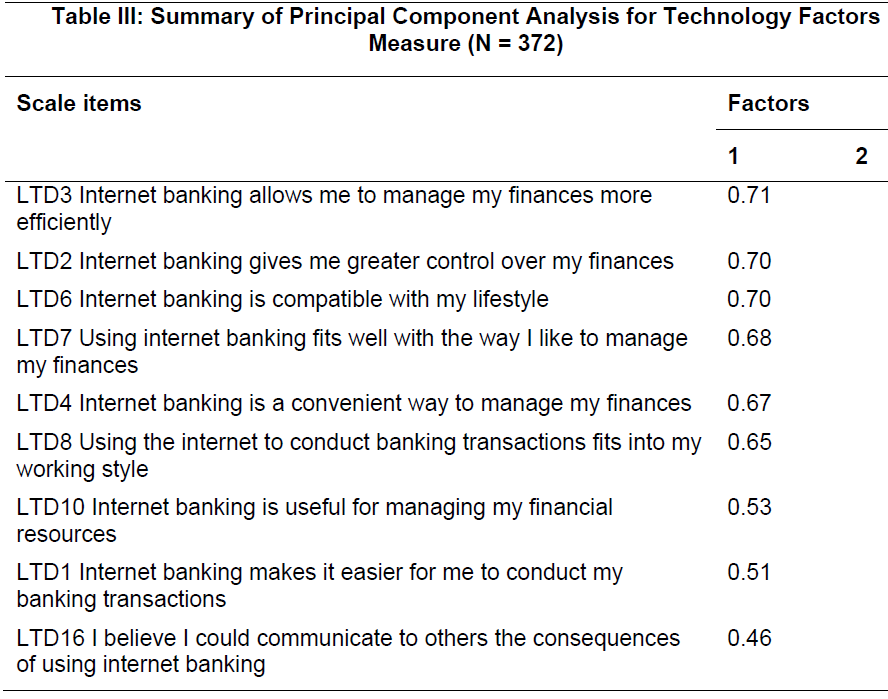 |
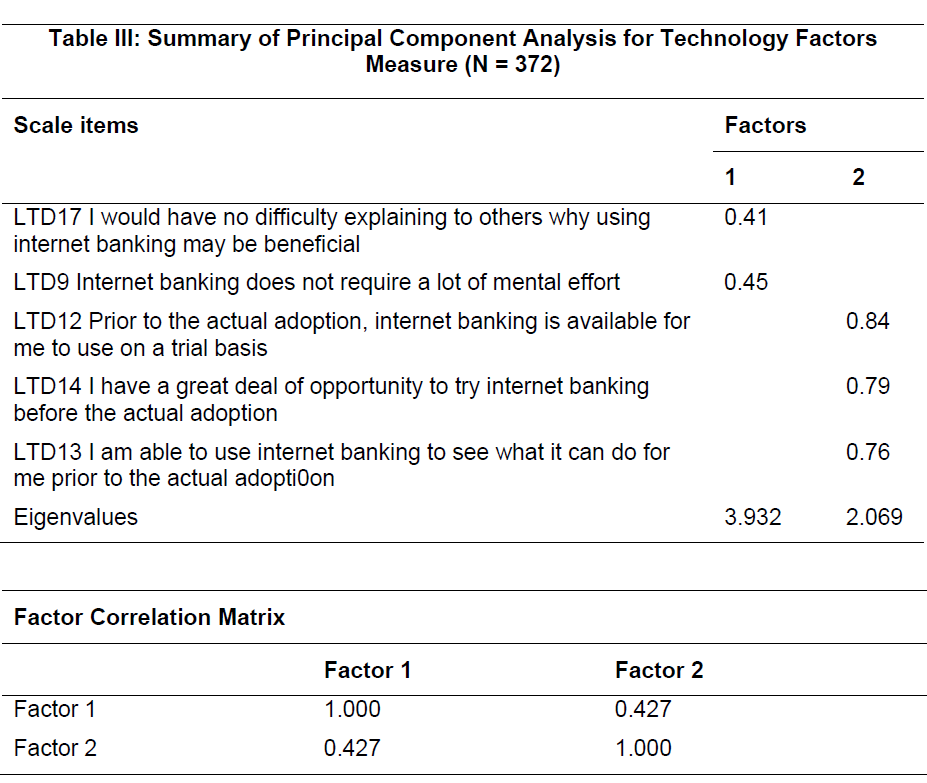 |
| The two technology factors components were labelled based on a review of the thematic content of the different items of their defining items. |
Component 1: Perceived Usability |
| This component consists of items relating to the consumer’s extent of ease and convenience with internet banking, compatibility with their personal and professional lifestyles and the extent to which they could communicate the benefits of internet banking usage to others. |
Component 2: Perceived Trialability |
| This component relates to the extent to which customers can actually try internet banking or any add on features with regard to internet banking on a limited basis before they actually consume the service. Customers are often comfortable with the trialability nature of internet banking as it can remove any technology apprehensions that persist with the customers. |
Principal Component Analysis Output for the Channel Factors |
| The results of the principal component analysis output for the channel factors are presented in Table IV. It is evident from the table that the KMO measure of sampling adequacy (0.773) and Bartlett’s test of Spherecity (p < 0.001) were satisfied. Using the Kaiser-Guttman retention criterion of eigenvalues greater than one, a two component solution provided the clearest extraction. These two components accounted for 36.593 percent of the total variance. The two component model was deemed to be the best solution because of its conceptual clarity and ease of interpretation. Also, the component correlation matrix reveals that the two emerged components of the channel-related factors to be moderately positively correlated (0.341) and are well discriminated. |
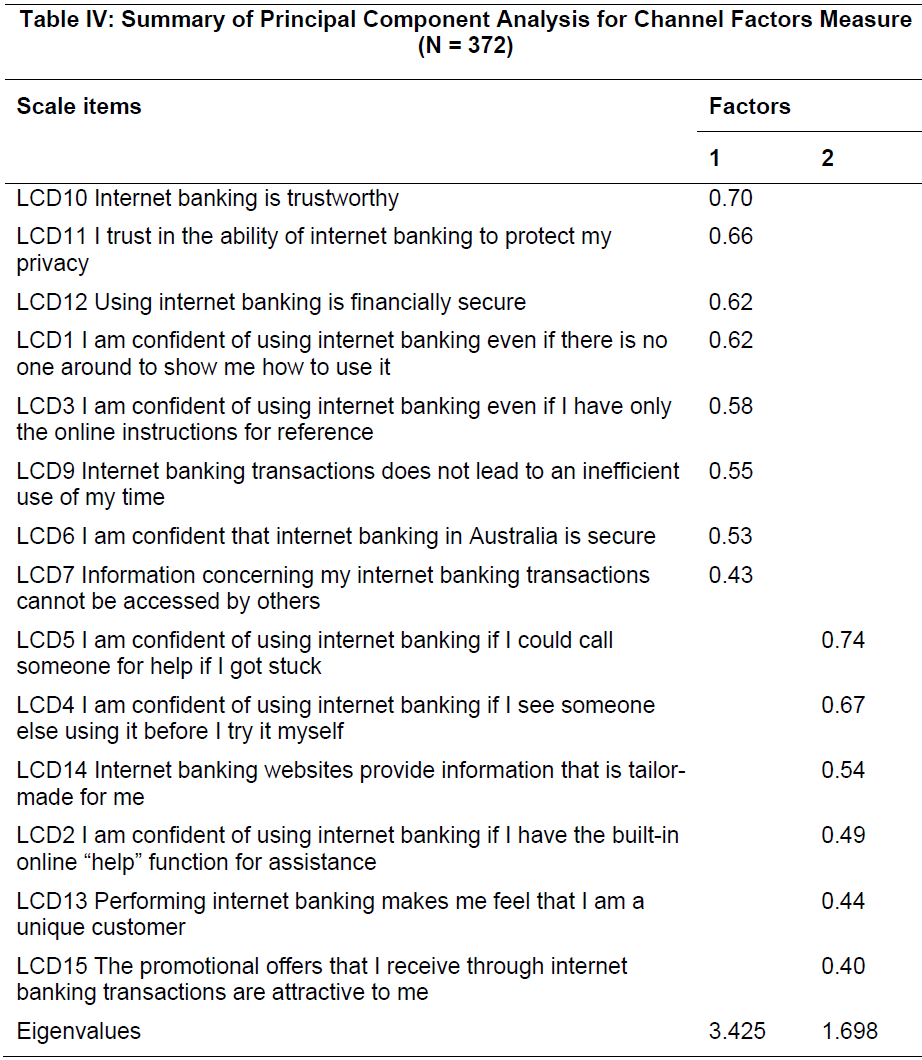 |
 |
| The two channel factors components were labelled based on a review of the thematic content of the different items of their defining items. |
Component 1: Perceived Safety |
| This component relates to the safety of internet banking with regard to the risk, security and trust associated by the consumers with internet banking as a service delivery channel. Moreover, the component included items related to the internal component of self-efficacy, indicating that internet banking users were confident that they can perform their transactions without any help. |
| Component 2: Perceived Specialty |
| This component is related to the personalisation component perceived by the consumers as unique and special customers due to internet banking. Also the component consists of the external component of self-efficacy, indicating less confidence associated with the internet banking consumers without the presence of a role model or online help functions. Principal Component Analysis Output for the Social Factors |
| The results obtained from the principal component analysis for the social factors are presented in Table V. The table shows that the minimum standard was attained before the data were subjected to the actual principal component analysis by satisfying the KMO measure of sampling adequacy (0.898) and Bartlett’s test of Spherecity (p < 0.001) indicating sufficient correlation between the variables. The Kaiser-Guttman retention criterion of eigenvalues greater than one, provided the clearest extraction of a one component solution. The resultant single component accounted for 64.725 percent of the total variance. |
 |
 |
| Principal component analysis for the social factors construct resulted in an extraction of a single solid component consisting of the scale items related to the influence exerted on the customer to use internet banking by the friends, family members and colleagues. |
Principal Component Analysis Output for the Value for money Factors |
| Table VI shows the principal component analysis solution for the value for money factors construct. It is evident that the KMO measures of sampling adequacy (0.824) and Bartlett’s test of Spherecity (p < 0.001) as prerequisites for running the principal component analysis were satisfied. The Kaiser-Guttman retention criterion of eigenvalues greater than one, provided the clearest extraction of one solid component solution. The resultant component accounted for 38.193 percent of the total variance. |
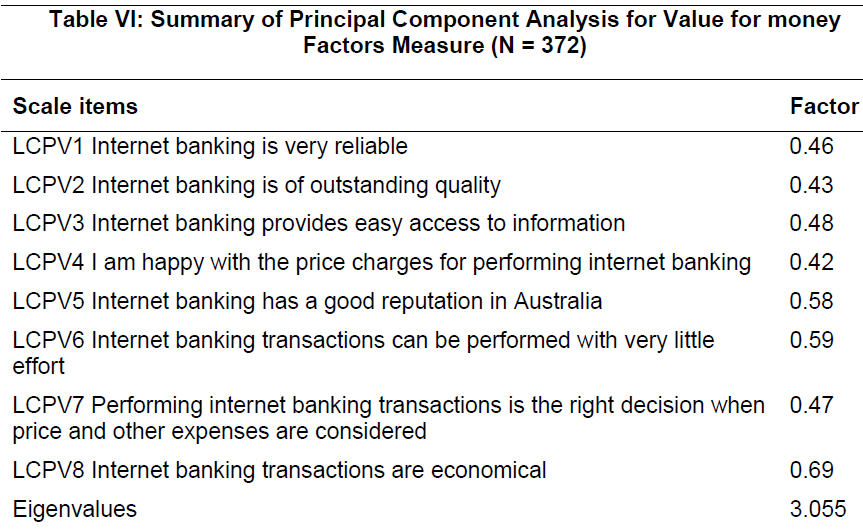 |
| The principal component analysis solution for the value for money factors resulted in the extraction of a single component consisting of the scale items representing the trade-off between the benefits and costs associated by the customer with the use of internet banking as a service delivery channel. |
Principal Component Analysis Output for the Continued Use Factors |
| Table VII displays the summary of principal component analysis for continued use factors measure. It is evident from the table that for the continued usage factor measure, the KMO measures of sampling adequacy (0.617) and Bartlett’s test of Spherecity (p < 0.001) as prerequisites for running the principal component analysis were satisfied. The Kaiser-Guttman retention criterion of eigenvalues greater than one, provided the clearest extraction of a single solid component solution. The resultant component accounted for 57.397 percent of the total variance. |
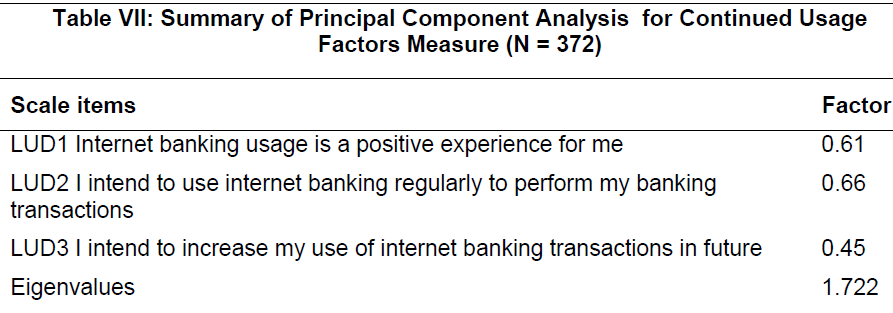 |
| Principal component analysis of the continued usage factor extracted a single component. The resultant component consists of scale items related to the customer’s associations with internet banking, intention to perform banking transactions through the internet regularly, and their intentions to increase the use of internet banking in future. |
Reliability Analysis |
| Reliability is the correlation of an item, scale, or instrument with a hypothetical one which truly measures what it is supposed to. Cronbach’s alpha is the most common form of internal consistency reliability coefficient. By convention, a lenient cut-off of 0.60 is common in exploratory research; alpha should be at least 0.70 or higher to retain an item in an ‘adequate scale’, and a cut-off of 0.80 is required for a ‘good scale’ (Graham 2006). In the present study, an approach guided by a lenient cut-off of 0.60 is considered to be appropriate. The reliability statistics for the scales identified via principal components analysis are presented in Table VIII. In order to validate reliability of the instrument, ensure measurement accuracy and check the internal consistency of each multi-item perceptual measure, Cronbach’s alpha values were calculated (Straub et al. 1995). In all cases, Cronbach’s alpha exceeded at least 0.60. For all subsequent analyses, respondents were given scores on each identified component or scale by averaging the scores on the items that defined that scale. |
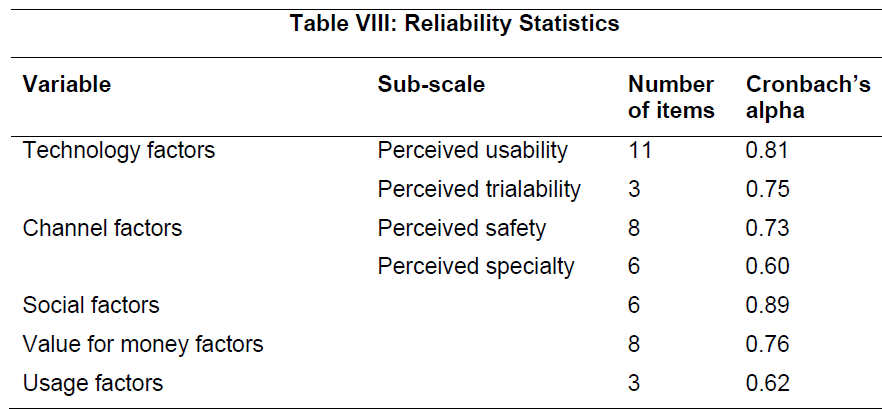 |
DISCUSSION |
| Exploratory factor analysis resulted in perceived usability and perceived trialability components of technology factors, perceived safety and perceived specialty components of channel factors and a single solid social and value factors. These results obtained from the principal component analysis evidently show that internet banking consumers predominantly look for the ease in using the technology-based service delivery option, its convenience, and its compatibility with their lifestyle, apart from their ability to communicate to others the benefits associated with the use of internet banking. The importance of the trialability nature with regard to consumers’ continued and frequent use enhances their comfort in performing technology-based transactions, specifically with any add-on features, and acts as a catalyst in increasing consumers’ actual use. Existing literature with regard to pre-adoption and adoption studies identified components such as relative advantage, compatibility, complexity, trialability and result demonstrability as influential in consumers’ acceptance of internet banking. The present study identified perceived usability and perceived trialability components as influential to consumers’ post-adoption behaviour. The perceived usability component consisted of dimensions relating to the ease of using, convenient nature, speed of using, compatibility with lifestyle and communicating the advantages of internet banking to others. This implies that the more the consumers perceive the internet banking service delivery channel as being useful, the more they use it on a continued and frequent basis to perform their banking transactions. The perceived trialability component consisted of dimensions related to consumers’ attraction towards the trial option associated with internet banking performance and any newly added features. Thus, the more the consumers perceive internet banking as trialable, the more they use this service delivery channel on a continued and frequent basis to perform their banking transactions. Consumers’ perceptions related to the perceived usability and perceived trialability features were identified as influencing their internet banking adoption in the existing research (Ndubisi & Sinti 2006). However, even long after consumers’ adoption of internet banking, perceived usability and perceived trialability components in the present research were found to significantly influence consumers’ continued and frequent use of internet banking. |
| The perceived safety and perceived specialty components identified as channel-related factors were associated with the importance that consumers relate to the risk, security, trust, self-efficacy and personalisation aspects of the internet banking service delivery channel. The perceived safety component consisted of dimensions related to risk associated with the internet based channels, consumers’ perceptions of trust towards the internet banking channel, security-related issues associated with internet banking transactions and the necessary skills of the consumer to perform internet banking independently. These findings partly aligned with the existing literature that showed consumers’ perceptions regarding internet banking service delivery channel as safe and secure to perform their banking transactions received considerable attention in the existing literature pertaining to internet banking adoption as well as non-adoption research (Maijala 2004). Thus the more the consumers perceive that internet banking is safe and secure, the more they perform internet banking transactions continuously and frequently. The perceived specialty component consisted of dimensions related to personalisation measure and presence of others to help navigate through internet-based transactions. Consumers’ perceptions that internet banking is special encourage them to use internet banking transactions on a continued and frequent basis. |
| The emergence of the social factor as a single solid factor indicates that the influence of the subjective norm and interpersonal influence evident in consumers’ pre-adoption process were of no significance in their post-adoption. Social factors consisting of the subjective norm and interpersonal influence yielded a single factor solution. Thus the single factor of social influence consisted of dimensions related to influence exerted by friends, colleagues and family members to uptake internet banking. To date, the influence of social factors on internet banking adoption still provides challenges for the internet banking researchers. Therefore, it is expected that the more the influence of the salient referent groups such as friends, colleagues and family to the consumer, the more would be the usage of internet banking by the consumer on a continued and frequent basis. |
| Similarly, the emergence of the value for money component as a single solid factor depicts that the influence of the perceived benefits and perceived costs associated with consumers’ pre-adoption and adoption of internet banking was not obvious in their postadoption process. Value for money factors identified as a trade-off between consumers’ perceptions related to perceived benefits and perceived costs also yielded a single factor solution (Petrick 2002). Thus the value for money factor consisted of dimensions related to consumers’ perceptions towards economic value associated with the internet banking service delivery channel encompassing costs and benefits. The value for money factors were found to be significantly associated with consumers’ continued and frequent use of internet banking. Thus the more the consumers perceive internet banking as a valuebased offering compared to other service delivery channels, the more they tend to perform internet banking transactions on a continued and frequent basis. Understanding value perceptions from the customer perspective is relevant for managing and supporting both the bank’s and the customer’s value creation processes. Further, understanding the dimensions of the value for money factors in this study complements previous theories on customer perceived value and helps in conceptualisation of the value specific to the electronic services. Financial entities should provide service offers that generate value to their customers in a sustained way, in order to attain a competitive advantage and maintain it over time. Thus, bank management, marketers and service providers should increasingly look at the possibilities of providing business customer value and enhance their profitability. |
LIMITATIONS |
| One of the limitations associated with the current study is related to the reduced capacity to draw causal inferences that were inherent in the application of a survey type of research. The data for testing the conceptual model were obtained in a cross-sectional manner on a single occasion from a single source. Therefore the data collection method employed in this study had the potential for single source bias. Responses were obtained only from those respondents who agreed to answer the questionnaire by interception in a shopping mall. Therefore the findings invite speculation with regard to causal relations concerns and further testing would be essential for verification. The researcher, whilst conducting the analysis, performed transformations of the variables that were found to be skewed in their distributions. |
| Another limitation of this study is the use of self-report measures associated with consumers’ perceptions of internet banking. Such measures have the potential to confound findings due to common method variance. Although a limitation, nevertheless it was a convenient method that allowed the researcher to efficiently examine the large number of relevant variables from a wider sample. However, there was no sign of lack of discriminant validity, the usual sign of common method variance among the principal constructs. Also self-report measures have been successfully used in prior research (Yousafzai et al. 2005; Straub et al. 1995). While aiming to investigate the antecedents to consumers’ continued and frequent use of internet banking, the strength of the research lay in the reliability and goodness of fit measures of the final emerged components identified. Also the fact that most of the factors identified as a result of exploratory factor analysis exhibited consistency with the scale dimensions should increase the meaningfulness of these findings. The researcher, however, expects that these findings will motivate internet banking researchers to test the specific relationships examined in this study using other possible reliable measures and procedures and thus circumvent the problems associated with the use of self-reporting techniques. |
| The issue of generalisability is a limitation in most of the consumer behaviour studies and the present study is no exception. The study has been conducted in Australia and specifically targeted the retail banking consumers who were internet banking users and non-users. The resultant findings may vary with the application of the study to other banking contexts and other countries. |
References |
|
Copyright © 2025 Research and Reviews, All Rights Reserved